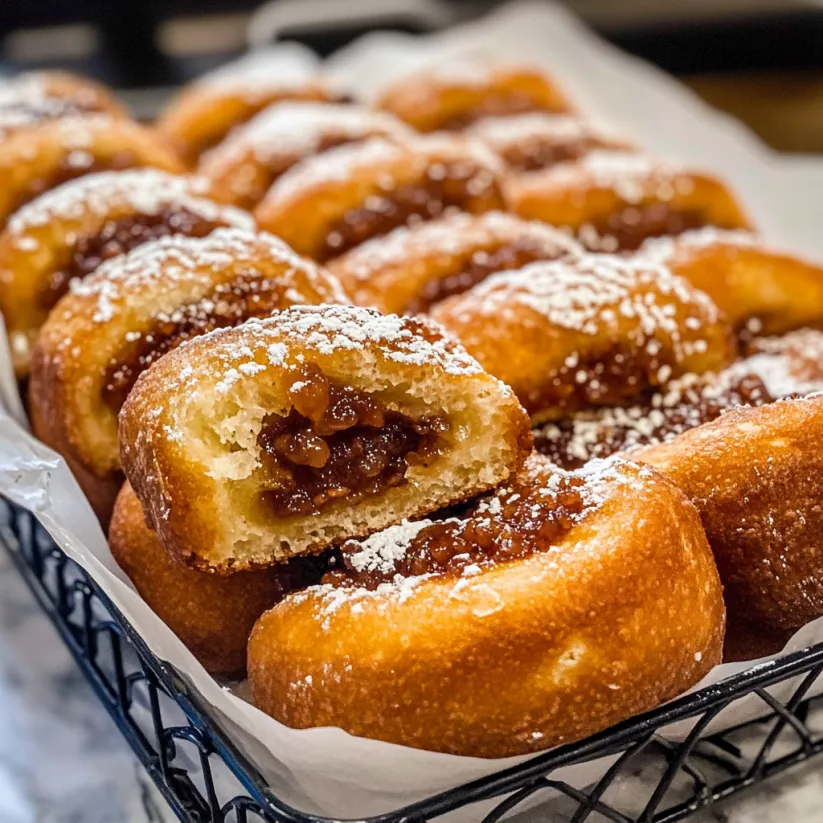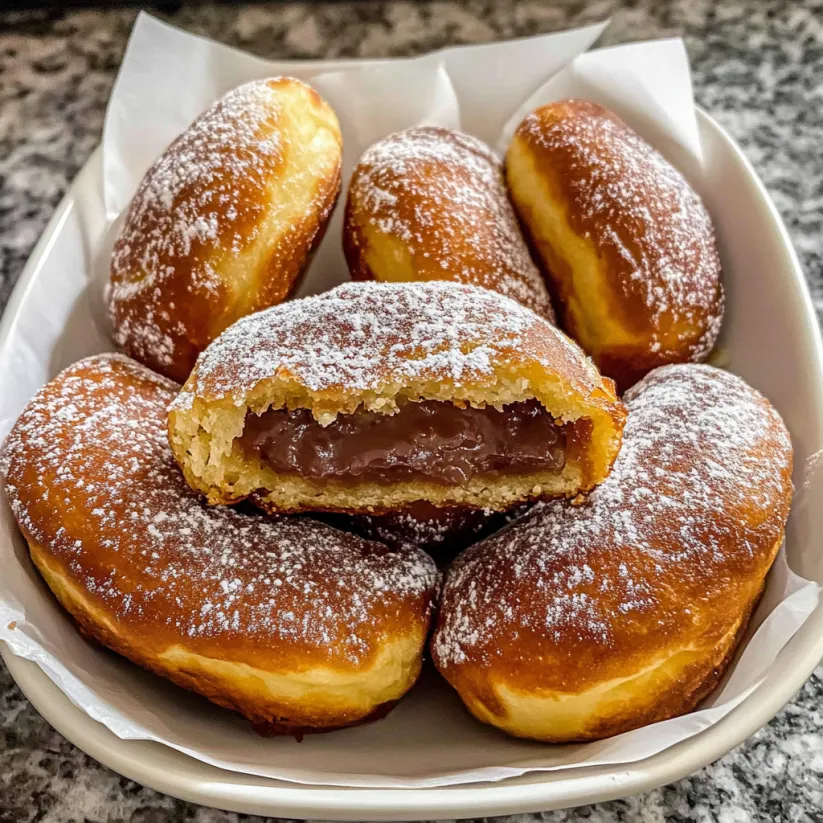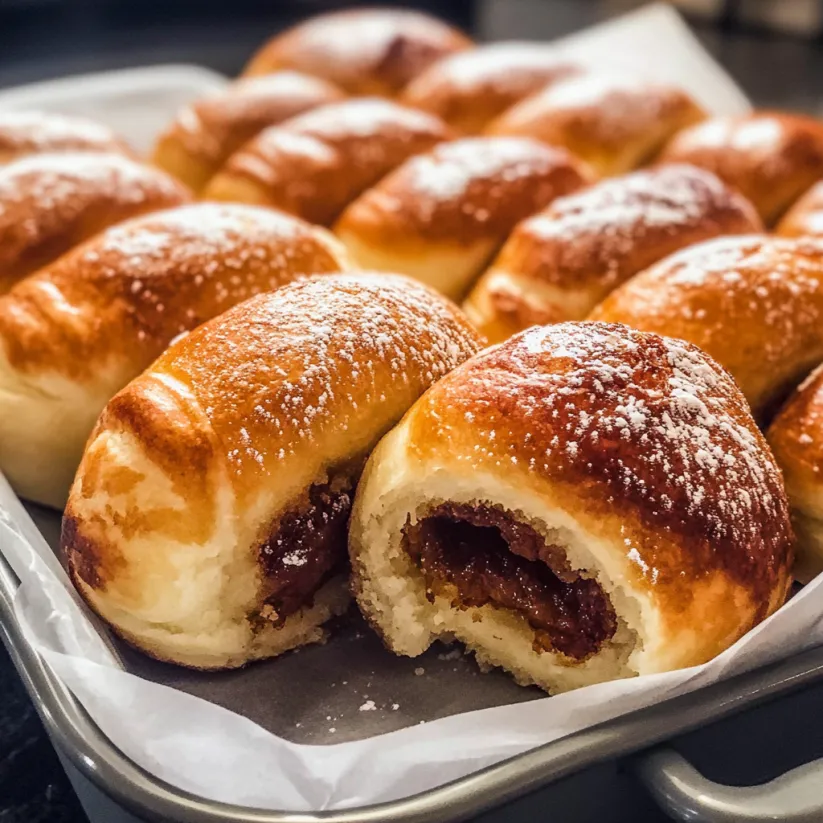 Save Pin
Save Pin
This fluffy, airy Portuguese donut recipe creates irresistible malasadas that are deep-fried to perfection and rolled in sugar. Whether filled with custard, jam, dulce de leche, or served plain, these traditional treats are impossible to resist after just one bite.
I first discovered malasadas during a trip to Hawaii where they're incredibly popular due to Portuguese influence. After one bite of these sugar-coated pillows of fried dough, I knew I had to recreate them at home. Now they're our family's special weekend treat tradition.
Ingredients
- Active dry yeast activates the dough and creates that airy texture. Always check expiration dates for best results
- Granulated sugar both sweetens the dough and creates the iconic coating. Use fine sugar for best coating results
- All-purpose flour provides structure while keeping them tender. Measure carefully for consistent results
- Lukewarm milk adds richness and creates a tender crumb. Full-fat works best for flavor
- Eggs provide structure and richness. Room temperature eggs incorporate more easily
- Frying oil creates the golden exterior. Neutral oils like canola or vegetable work best
- Salt enhances all flavors and balances sweetness. Don't skip this crucial ingredient
Step-by-Step Instructions
- Activate the Yeast
- Combine yeast, sugar and lukewarm water in your mixer bowl and let rest for 5 minutes until frothy on top. This crucial step ensures your dough will rise properly. If no froth appears, your yeast may be dead and you'll need to start over with fresh yeast.
- Mix the Dough
- Add flour, remaining sugar, salt, milk and eggs to the activated yeast mixture. Mix with the dough hook attachment for 5 to 8 minutes until the dough is smooth and pulls away from the sides of the bowl. The dough should feel soft and elastic but not sticky. Add flour one tablespoon at a time if needed.
- First Rise
- Place dough in a lightly greased bowl and cover with a towel or plastic wrap. Let rise in a warm, draft-free spot until doubled in size, about 1 to 1½ hours. The dough should look puffy and feel light when touched.
- Shape the Dough
- Punch down the risen dough to release air bubbles. Transfer to a lightly floured surface and roll into a 9x12-inch rectangle. Cut into 12 pieces and place on a parchment-lined baking sheet. For smaller malasadas, you can cut each piece in half.
- Second Rise
- Cover the shaped dough with a clean towel and let rise again for 30 minutes. This second rise creates extra lightness in the finished malasadas. The pieces should look visibly puffed up.
- Fry to Perfection
- Heat oil in a Dutch oven to 350°F. Fry 3 to 4 malasadas at a time, turning once, until golden brown on both sides, about 1 to 2 minutes per side. Watch carefully as they cook quickly. Properly fried malasadas should puff up dramatically.
- Drain and Finish
- Transfer fried malasadas to a paper towel-lined plate to absorb excess oil. While still warm, roll in sugar to coat completely. The heat helps the sugar adhere better. Serve immediately or fill as desired.
 Save Pin
Save Pin
My absolute favorite way to enjoy these is when they're still slightly warm, with a crisp exterior giving way to that pillowy interior. My children gather around the kitchen when they smell the oil heating, knowing these treats are only minutes away. The joy on their faces is worth every minute of preparation.
The History Behind Malasadas
Malasadas originated in Portugal, specifically in the Azores islands, and were traditionally made to use up eggs and sugar before Lent began. Portuguese immigrants brought these treats to Hawaii in the 19th century while working on sugar plantations. Today, they're an iconic Hawaiian treat, especially popular on Fat Tuesday, known as Malasada Day. The authentic version contains no hole in the center, distinguishing them from traditional American donuts.
Filling Options
Transform basic malasadas into extraordinary treats by adding fillings. For custard filling, use a pastry bag with a filling tip to pipe vanilla custard, chocolate pudding, or coconut cream into the side of each cooled malasada. Fruit fillings like raspberry jam or pineapple preserves add tropical flair. Dulce de leche or Nutella create rich, decadent variations. Insert the tip about halfway into the malasada and fill until you feel slight resistance.
Storing Malasadas Properly
Malasadas truly shine when eaten fresh, but proper storage can extend their life. For same-day enjoyment, keep them at room temperature in a paper bag or loosely covered container to maintain their texture. For overnight storage, place in an airtight container in the refrigerator and reheat in a toaster oven for 3-5 minutes at 300°F before serving. For longer storage, freeze unfilled and uncoated malasadas for up to one month, then thaw, warm, and coat with sugar before serving.
 Save Pin
Save Pin
Commonly Asked Questions
- → What are Malasadas?
Malasadas are traditional Portuguese donuts that are deep-fried until golden brown and typically rolled in sugar. They have a fluffy, airy texture and can be served plain or filled with custard, jam, or dulce de leche.
- → How do I know if my yeast is activated properly?
Your yeast mixture should become frothy on top after about 5 minutes of resting. If you don't see this frothy texture, your yeast may be expired or the water temperature wasn't correct (it should be lukewarm, 95°-105°F). You'll need to start over with fresh yeast.
- → Can I make Malasadas ahead of time?
Malasadas are best eaten the same day they're made. However, you can store them overnight in the refrigerator and reheat them in a toaster oven the next day to maintain some of their freshness.
- → What fillings work well with Malasadas?
Traditional fillings include custard, fruit jams (especially tropical flavors), lemon curd, and dulce de leche. You can also enjoy them plain with just the sugar coating for a simpler but equally delicious treat.
- → What's the best oil for frying Malasadas?
A neutral oil with a high smoke point works best, such as vegetable oil, canola oil, or peanut oil. Maintain the oil temperature at 350°F for optimal results - too hot and they'll brown too quickly without cooking inside, too cool and they'll absorb too much oil.
- → How can I tell when Malasadas are done frying?
Properly fried Malasadas should be puffed up and golden brown on all sides, which typically takes about 1-2 minutes per side. They should float in the oil rather than sink to the bottom.
